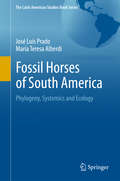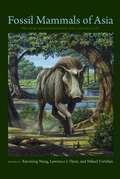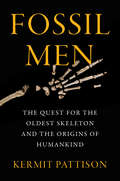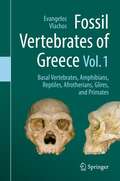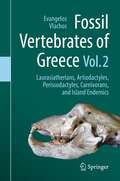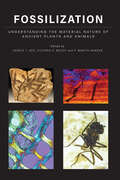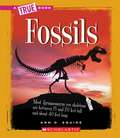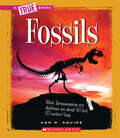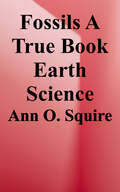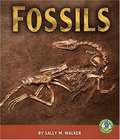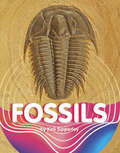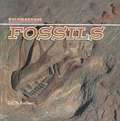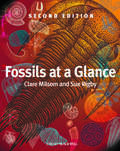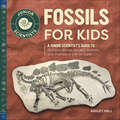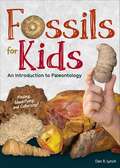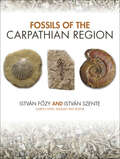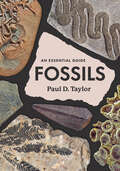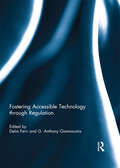- Table View
- List View
Fossil Horses of South America
by José Luis Prado María Teresa AlberdiThis book provides an update on the phylogeny, systematics and ecology of horses in South America based on data provided over the past three decades. The contemporary South American mammalian communities were shaped by the emergence of the Isthmus of Panama and by the profound climatic oscillations during the Pleistocene. Horses were a conspicuous group of immigrant mammals from North America that arrived in South America during the Pleistocene. This group is represented by 2 genera, Hippidion and Equus, which include small species (Hippidion devillei, H. saldiasi, E. andium and E. insulatus) and large forms (Equus neogeus and H. principale). Both groups arrived in South America via 2 different routes. One model designed to explain this migration indicates that the small forms used the Andes corridor, while larger horses used the eastern route and arrived through some coastal areas. Molecular dating (ancient DNA) suggests that the South American horses separated from the North American taxa (caballines and the New World stilt-legged horse) after 3.6 - 3.2 Ma, consistent with the final formation of the Panamanian Isthmus. Recent studies of stable isotopes in these horses indicate an extensive range of 13C values cover closed woodlands to C4 grasslands. This plasticity agrees with the hypothesis that generalist species and open biome specialist species from North America indicate a positive migration through South America.
Fossil Mammals of Asia: Neogene Biostratigraphy and Chronology
by Wang Lawrence J. Flynn Mikael Fortelius Eds. XiaomingFossil Mammals of Asia, edited by and with contributions from world-renowned scholars, is the first major work devoted to the late Cenozoic (Neogene) mammalian biostratigraphy and geochronology of Asia. This volume employs cutting-edge biostratigraphic and geochemical dating methods to map the emergence of mammals across the continent. Written by specialists working in a variety of Asian regions, it uses data from many basins with spectacular fossil records to establish a groundbreaking geochronological framework for the evolution of land mammals.Asia's violent tectonic history has resulted in some of the world's most varied topography, and its high mountain ranges and intense monsoon climates have spawned widely diverse environments over time. These geologic conditions profoundly influenced the evolution of Asian mammals and their migration into Europe, Africa, and North America. Focusing on amazing new fossil finds that have redefined Asia's role in mammalian evolution, this volume synthesizes information from a range of field studies on Asian mammals and biostratigraphy, helping to trace the histories and movements of extinct and extant mammals from various major groups and all northern continents, and providing geologists with a richer understanding of a variety of Asian terrains.
Fossil Mammals of Asia: Neogene Biostratigraphy and Chronology
by Xiaoming Wang Lawrence J. Flynn Mikael ForteliusFossil Mammals of Asia, edited by and with contributions from world-renowned scholars, is the first major work devoted to the late Cenozoic (Neogene) mammalian biostratigraphy and geochronology of Asia. This volume employs cutting-edge biostratigraphic and geochemical dating methods to map the emergence of mammals across the continent. Written by specialists working in a variety of Asian regions, it uses data from many basins with spectacular fossil records to establish a groundbreaking geochronological framework for the evolution of land mammals. Asia s violent tectonic history has resulted in some of the world s most varied topography, and its high mountain ranges and intense monsoon climates have spawned widely diverse environments over time. These geologic conditions profoundly influenced the evolution of Asian mammals and their migration into Europe, Africa, and North America. Focusing on amazing new fossil finds that have redefined Asia s role in mammalian evolution, this volume synthe sizes information from a range of field studies on Asian mammals and biostratigraphy, helping to trace the histories and movements of extinct and extant mammals from various major groups and all northern continents, and providing geologists with a richer understanding of a variety of Asian terrains.
Fossil Men: The Quest for the Oldest Skeleton and the Origins of Humankind
by Kermit Pattison"A rip-roaring tale, Fossil Men is one of those rare books that can be a prism through which to view the world, exposing the fabric of the Earth and illuminating the Tree of Life." —New York Times bestselling author Peter NicholsA decade in the making, Fossil Men is a scientific detective story played out in anatomy and the natural history of the human body: the first full-length account of the discovery of a startlingly unpredicted human ancestor more than a million years older than LucyIt is the ultimate mystery: where do we come from? In 1994, a team led by fossil-hunting legend Tim White uncovered a set of ancient bones in Ethiopia’s Afar region. Radiometric dating of nearby rocks indicated the resulting skeleton, classified as Ardipithecus ramidus—nicknamed “Ardi”—was an astounding 4.4 million years old, more than a million years older than the world-famous “Lucy.” The team spent the next 15 years studying the bones in strict secrecy, all while continuing to rack up landmark fossil discoveries in the field and becoming increasingly ensnared in bitter disputes with scientific peers and Ethiopian bureaucrats. When finally revealed to the public, Ardi stunned scientists around the world and challenged a half-century of orthodoxy about human evolution—how we started walking upright, how we evolved our nimble hands, and, most significantly, whether we were descended from an ancestor that resembled today’s chimpanzee. But the discovery of Ardi wasn’t just a leap forward in understanding the roots of humanity--it was an attack on scientific convention and the leading authorities of human origins, triggering an epic feud about the oldest family skeleton.In Fossil Men, acclaimed journalist Kermit Pattison brings us a cast of eccentric, obsessive scientists, including White, an uncompromising perfectionist whose virtuoso skills in the field were matched only by his propensity for making enemies; Gen Suwa, a Japanese savant whose deep expertise about teeth rivaled anyone on Earth; Owen Lovejoy, a onetime creationist-turned-paleoanthropologist with radical insights into human locomotion; Berhane Asfaw, who survived imprisonment and torture to become Ethiopia’s most senior paleoanthropologist; Don Johanson, the discoverer of Lucy, who had a rancorous falling out with the Ardi team; and the Leakeys, for decades the most famous family in paleoanthropology. Based on a half-decade of research in Africa, Europe and North America, Fossil Men is not only a brilliant investigation into the origins of the human lineage, but the oldest of human emotions: curiosity, jealousy, perseverance and wonder.
Fossil Primates
by Susan CachelReconstructing the paleobiology of fossil non-human primates, this book is intended as an exposition of non-human primate evolution that includes information about evolutionary theory and processes, paleobiology, paleoenvironment, how fossils are formed, how fossils illustrate evolutionary processes, the reconstruction of life from fossils, the formation of the primate fossil record, functional anatomy, and the genetic bases of anatomy. Throughout, the emphasis of the book is on the biology of fossil primates, not their taxonomic classification or systematics, or formal species descriptions. The author draws detailed pictures of the paleoenvironment of fossil primates, including contemporary animals and plants, and ancient primate communities, emphasizing our ability to reconstruct lifeways from fragmentary bones and teeth, using functional anatomy, stable isotopes from enamel and collagen, and high resolution CT-scans of the cranium. Fossil Primates will be essential reading for advanced undergraduates and graduate students in evolutionary anthropology, primatology and vertebrate paleobiology.
Fossil Vertebrates of Greece Vol. 1: Basal vertebrates, Amphibians, Reptiles, Afrotherians, Glires, and Primates
by Evangelos VlachosThis 2-volume set provides a state-of-the-art study of the fossil record and taxonomy of the main vertebrate groups from Greece. Greece stands between 3 continents and its vertebrate fossil record is of great importance for paleontological and evolutionary studies in Europe, Asia and Africa. Fossils from classic, world-famous localities (e.g., Pikermi, Samos) form an essential part of the collections of the most important museums in the world and have been studied by numerous scientists. Recent paleontological research led to the discovery and study of numerous new sites. The volumes contain a taxonomic review of all named and identified taxa, their taxonomic history and current status, as well as historical, phylogenetic and biogeographic information. Volume 1 contains a synopsis of the fossil record and taxonomy of important groups of vertebrates represented in the fossil record of Greece. The volume deals with some of the early splitting clades, including the basal and enigmatic conodonts and basal tetrapods like fishes, amphibians, and reptiles like lizards, snakes, crocodiles, turtles and tortoises. The second part of the volume deals with basal mammalian clades, some of which are quite characteristic for the fossil record of the country: aardwarks, hyraxes, proboscideans, elephants and mammoths, sea cows, rodents, and lagomorphs. The volume ends with special chapters on the primate fossil record of the country, including some of our most recent and distant relatives.
Fossil Vertebrates of Greece Vol. 2: Laurasiatherians, Artiodactyles, Perissodactyles, Carnivorans, and Island Endemics
by Evangelos VlachosThis 2-volume set provides a state-of-the-art study of the fossil record and taxonomy of the main vertebrate groups from Greece. Greece stands between 3 continents and its vertebrate fossil record is of great importance for paleontological and evolutionary studies in Europe, Asia and Africa. Fossils from classic, world-famous localities (e.g., Pikermi, Samos) form an essential part of the collections of the most important museums in the world and have been studied by numerous scientists. Recent paleontological research led to the discovery and study of numerous new sites. The volumes contain a taxonomic review of all named and identified taxa, their taxonomic history and current status, as well as historical, phylogenetic and biogeographic information. Volume 2 contains a synopsis of the fossil record and taxonomy of important groups of mammals represented in the fossil record of Greece. The volume starts with specific chapters on laurasiatherians like insectivores and bats, moving on to the main part of the book that deals with three of the most important fossil groups in the country. The fossil record of even-toed animals is summarized with chapters on bovids, cervids, suoids, anthracotheres, hippos, giraffes, and tragulids. The fossil record of odd-toed animals is presented with special chapters on horses, tapirs, rhinos, and chalicotheres. The last part of this volume deals with meat-eating, carnivoran groups, like felids, viverrids, hyaenas, canids, bears, ailurids, mephitids and mustelids. The volume ends with a special chapter on insular endemic mammals from the various islands of Greece.
Fossilization: Understanding the Material Nature of Ancient Plants and Animals
by Carole T. Gee, Victoria E. McCoy, and P. Martin SanderAn in-depth look at the latest breakthroughs in our understanding of the material record that deep time leaves behind.Understanding the complex interplay of physical and chemical processes leading to fossilization is crucial to elucidating the 3800 million years of life on earth. And yet, the process of fossilization also leads to the loss of pivotal biological information, placing constraints on the very same understanding of ancient life it preserves. Over the last decade, however, remarkable advances in approaches, techniques, tools, and instrumentation have helped scientists to transcend these constraints by enabling high-resolution analysis of fossil material—even down to the nanoscale. Fossilization provides a critical look at these cutting-edge innovations in the science of fossil preservation and provides a road map for future research. Drawing from the fields of paleontology, organic and inorganic chemistry, microbiology, and high-resolution imaging and analysis, and spanning the diversity of life from plants to vertebrates and invertebrates, this resource details expert findings on• fossilization of hard and soft part tissues in dinosaurs• high-resolution chemical analysis of organic and inorganic tissues• arthropods preserved in amber• experimental silicification of wood• chemical defenses and color in fossil plants • confocal Raman spectroscopy• microprobe analysis• radioisotopic studies• and much moreA true interdisciplinary undertaking, the book is authored by paleontologists, mineralogists, geochemists, organic chemists, microbiologists, and materials scientists who have worked together to investigate questions around substance fossilization and the limits of the fossil record. A special color section contains SEM, Raman, and other striking images of vertebrates, invertebrates, and plants. Fossilization is a trailblazing reference book for research scientists and specialists in related fields, as well as for advanced undergraduates and graduate students interested in fossilization, emerging research techniques, and fresh approaches in the analysis of plant and animal fossils.Contributors: H. Jonas Barthel, Aurore Canoville, Carole T. Gee, Thorsten Geisler, Jens Götze, Conrad C. Labandeira, Sashima Läbe, Moritz Liesegang, Victoria E. McCoy, Martina Menneken, Jes Rust, P. Martin Sander, Frank Tomaschek, Torsten Wappler, Kayleigh Wiersma, Tzu-Ruei Yang
Fossils
by Ann O. SquireDid you ever wonder how scientists have learned so much about Earth's history? How do we know what the dinosaurs looked like, what they ate, or where they lived? How do we know that fish existed before mammals? How have we learned about our human ancestors? <p><p>The answer to these questions is through the study of fossils. Fossils are the remains, or traces, of animals and plants that have been preserved in the earth's rocky crust.
Fossils (A True Book (Relaunch))
by Ann O. SquireFossils are one of the most important tools we have for learning about long-extinct wildlife.A True Book: Earth Science series presents fascinating facts and fun activities that will engage the budding earth scientist, while exploring the fields of geology, meteorology, ecology, and more. This series includes an age appropriate (grades 3-5) introduction to curriculum-relevant subjects and a robust resource section that encourages independent study.In the 4.6 billion years since Earth was formed, many plant and animal species have come and gone. Readers will discover how fossils are formed, how paleontologists search for them, and what kinds of information they can provide.
Fossils (A True Book (relaunch): Earth Science Series)
by Ann O. SquireFossils are one of the most important tools we have for learning about long-extinct wildlife. A True Book: Earth Science series presents fascinating facts and fun activities that will engage the budding earth scientist, while exploring the fields of geology, meteorology, ecology, and more. <p><p>This series includes an age appropriate (grades 3-5) introduction to curriculum-relevant subjects and a robust resource section that encourages independent study. In the 4.6 billion years since Earth was formed, many plant and animal species have come and gone. Readers will discover how fossils are formed, how paleontologists search for them, and what kinds of information they can provide.
Fossils (Early Bird Earth Science)
by Sally M. WalkerFossils are the hardened remains of plants and animals. Remains are parts left behind after plants or animals die. All fossils are old. Fossils are the traces and remains of plants and animals that lived more than 10,000 years ago.
Fossils (Earth Materials and Systems)
by Keli SipperleyPlants and animals from millions of years ago left behind fossils. Fossils can teach people about the past. They are also used for fuel. Discover why fossils are an important part of nature!
Fossils (Kaleidoscope)
by Roy A. GallantDescribes what fossils are, how they are formed, and what they tell scientists about earth's past.
Fossils (Rocks and Minerals)
by Melissa StewartHave you ever wondered how fossils are formed, or why so many fossils are found in tar pits? Do you know what a coprolite is? How do scientists determine a fossil's age? Read Fossils to find the answers to these questions and many more. You'll also find a hands-on activity to try at home or at school, as well as a glossary of unfamiliar words, resources to help you locate additional information, and a useful index.
Fossils Tell of Long Ago (Let's-Read-and-Find-Out Science 2)
by AlikiWhat is a fossil?Sometimes it's the imprint of an ancient leaf in a rock. Sometimes it's a woolly mammoth, frozen for thousands of years in the icy ground. Sometimes it's the skeleton of a stegosaurus that has turned to stone.A fossil is anything that has been preserved, one way or another, that tells about life on Earth. But you can make a fossil, too—something to be discovered a million years from now—and this book will tell you how.
Fossils at a Glance
by Sue Rigby Clare MilsomFossils provide a powerful tool for the study of the nearly 4-billion-year history of life, and its role in the evolution of Earth systems. They also provide important data for evolutionary studies, and contribute to our understanding of the extinction of organisms and the origins of modern biodiversity. Fossils At A Glance is written for students taking an introductory level course in paleontology. Short chapters introduce the main topics in the modern study of fossils. The most important fossil groups are discussed, from microfossils through invertebrates to vertebrates and plants, followed by a brief narrative of life on Earth. Diagrams are central to the book and allow the reader to see most of the important data “at a glance”. Each topic covers two pages and provides a self-contained suite of information or a starting point for future study. This second edition has been thoroughly revised and brought up to date. It includes new line diagrams as well as photographs of selected fossils
Fossils for Kids: A Junior Scientist's Guide to Dinosaur Bones, Ancient Animals, and Prehistoric Life on Earth (Junior Scientists)
by Ashley HallUncover the ancient past—a guide to fantastic fossils for kids ages 6 to 8Set off on an amazing adventure into the prehistoric past when dinosaurs roamed the Earth. Fossils for Kids is filled with fascinating photographs and captivating facts that will teach junior fossil hunters how fossils form, where they are found, and tips on how to identify them.Start by learning more about some of your favorite dinosaurs—from Velociraptor to Tyrannosaurus rex—and where you can see the coolest dinosaur skeletons. Then discover the creatures that predate even the dinosaurs! You'll meet famous birds, like the Archaeopteryx, explore tiny invertebrate trilobites, and learn which ancient plant is the source of a delicious drink—root beer!Fossils for Kids includes:Beyond dinos—You won't just be learning about dinosaurs; this book covers mammals, other reptiles, and plant fossils.Greater knowledge—Use the fun sidebars to dive deeper into the fossil world and get more hands-on learning.Clear images—The colorful pictures allow you to easily identify fossils.It's time to unearth your scientific curiosity—there's no telling what you'll find using Fossils for Kids as your guide.
Fossils for Kids: An Introduction to Paleontology
by Dan R. LynchAs incredible as it sounds, fossils are all around us, waiting to be discovered. Become a young paleontologist. Learn all about ancient lifeforms preserved in rock. Dan R. Lynch, author of many Rocks & Minerals field guides, presents a kids’ introduction to fossils. Begin by learning about the early Earth and the process of fossilization. That’s followed by an identification guide to the most common and collectible fossils: crinoids, snail shells, shark teeth, and more. With full-color photographs and illustrations, you’ll always know what to look for. A “how to” section includes the details your family needs to begin a successful fossil hunt. You’ll also get information on everything from rock shop fossils and rules of collecting to dinosaur fossils and more. So learn to find, identify, and even collect the petrified forms of ancient organisms. Whether children see their first fossil at a museum or find their own fossil seashells, this easy-to-understand book is a perfect guide for beginners.
Fossils of the Carpathian Region (Life of the Past)
by István Szente István FozyA comprehensive review of the fossil record of the Carpathian Basin.Fossils of the Carpathian Region describes and illustrates the region’s fossils, recounts their history, and tells the stories of key people involved in paleontological research in the area. In addition to covering all the important fossils of this region, special attention is given to rare finds and complete skeletons. The region’s fossils range from tiny foraminifera to the Transylvanian dinosaurs and mammals of the Carpathian Basin. The book also gives nonspecialists the opportunity to gain a basic understanding of paleontology. Sidebars present brief biographies of important figures and explain how to collect, prepare, and interpret fossils.“An excellently written scientific book. . . . The good illustrations are an incentive to start reading and dive into the wide area covered by two experts in their respective fields. . . . A rich source of otherwise not published background knowledge on the paleontology and geology of the region.” —Christian A. Meyer, Natural History Museum, Basel“Fossils of the Carpathian Region . . . is beautifully produced with high-quality color illustrations throughout and an exhaustive bibliography and index. . . . Highly recommended.” —Choice“This book fills a gap in the geological texts on the Carpathians, especially in Hungary, and offers a valuable wealth of geological-paleontological and scientific-historical information from the Ordovician to the Pleistocene. This extensive and relatively inexpensive work is an unrivaled recommendation for amateurs and amateur geologists / paleontologists.” —Zentralblatt für Geologie und Paläontologie [translated from German]
Fossils: An Essential Guide
by Paul D. TaylorWith stunning images and an expert guide, explore the world of fossils to uncover the story of life on Earth, from the origins of new life to mass extinctions. Ancient Earth seems like an alien world. But the fossil record can help reveal the mysteries of the organisms that have lived on our planet since its formation some 4,600 million years ago. In this engaging and beautifully illustrated book, world-renowned paleontologist Paul D. Taylor provides a comprehensive guide to all aspects of fossils to tell the story of life on Earth. Taylor begins with the basics: how fossils form, how they mark geological time, and what they tell us about the origins of life and major evolutionary events like the Cambrian Explosion. He then shows the oldest fossils—single-celled bacteria in amazing, three-billion-year-old microbial rock structures—before introducing the first animals in the fossil record. From fishes to amphibians, reptiles, and mammals, we meet these animal fossils in an appropriate evolutionary parade. Next, we imagine plants long past, charting the evolution of this kingdom and learning how ephemeral botanical remains can become permanent records. While comprehensive in his coverage of fossil groups and ages, Taylor pays particular attention to specimens fossil hunters are most likely to encounter, like crinoids and the iconic ammonites. Throughout, he introduces us to fascinating fossil folklore—like the idea that ammonites are the petrified remains of coiled snakes—and helps us distinguish true fossils from fakes. With stunning color images of many original specimens from the collections of London’s Natural History Museum, Fossils is an essential introduction, connecting life on Earth today to the ancient past.
Fossils: The Key to the Past
by Richard A. ForteyA guide for amateur fossil collectors and general readers to how fossils came about, how to find and identify them, and their economic and practical importance. Emphasizes fossils easy to find. Includes a short glossary without pronunciation.
Fostering Accessible Technology through Regulation
by Delia Ferri and G. Anthony GiannoumisTechnology has attracted an increasing level of attention within studies of disability and disability rights. Many researchers and advocates have maintained skepticism towards technology out of the fear that technology becomes another way to ‘fix’ impairments. These skeptical views, however, contrast with a more positive approach towards the role that technology can play in eliminating barriers to social participation. Legal scholarship has started to focus on accessibility and accessible technology and in conjunction with the recently adopted United Nations Convention on the Rights of Persons with Disabilities has put a great emphasis on accessibility, highlighting the role that accessible technology plays in the promotion and protection of the rights of people with disabilities. Against this background, this book gathers together different contributions that focus on enhancing the production, marketing and use of accessible technology. Building upon previous academic studies and in light of the UNCRPD, accessible technology is considered a tool to increase autonomy and participation. Overall, this book attempts to show, through a multifaceted and inter-disciplinary analysis, that different regulatory approaches might enhance accessible technology and its availability. This title was previously published as a special issue of the International Review of Law, Computers & Technology.
